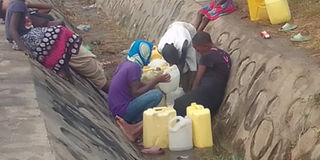Water scarcity hits Kasese

What you need to know:
- Mr Sharif Masereka, the chairperson of Kidodo Cell in Central Division, said the government constructed boreholes in every village as an alternative source of water.
Shortage of water has hit some parts of Kasese District, forcing residents to look for alternatives in drainage channels or far away sources.
Locals say they haven’t seen any drop of water for close to four months on the tap stands of the National Water and Sewerage Corporation .
The most affected people are from Bulembia Division, Nyamwamba Division, Central Division, Karambi, Katwe-Kabatoro, Kitswamba, Mpondwe/Lhubiriha, and Hima Town Council.
In Kasese Municipality, which mainly accesses water from the utility company, residents say the scarcity is affecting businesses.
Ms Fazila Kabugho, 30, a mother of four, said for the past month, they have resorted to fetching water from drainage channels.
“We have been walking many kilometres to River Nyamwamba to fetch water, but there is free water nearer to us from drainage channels, which we resorted to using,” she said.
Ms Jennifer Asimawe, another resident, said they used to depend on rainwater, but the rainfall pattern has changed.
“We fetch this water in the drainage channel and at times boil it to prevent waterborne diseases,” he said.
Mr Sharif Masereka, the chairperson of Kidodo Cell in Central Division, said the government constructed boreholes in every village as an alternative source of water.
“If the government establishes boreholes in a space of 10 homesteads, I am sure our young girls and wives who wake up early morning to go and fetch water won’t be exposed to rape and forced marriages,” Mr Masereka said.
NWSC responds
The manager of National Water and Sewerage Corporation - Kasese branch, Mr Peter Ebwat, said they are working hard to address the challenge of water shortage.
“We are constructing a water reserve that the population of Kasese will depend on. The problem will be minimised, we apologise for the inconvenience caused,” Mr Ebwat said.
Access to water
In Kasese District, 55 percent of people are served by national water, 36 percent by springs, four percent (shallow wells), and five percent (bore wells), according to the utility provider.
According to the Water ministry, access to safe water in Kasese stands at 60 percent. In some sub-counties such as Kyondo it’s at 18 percent, Mukunyu (20 percent), Kyarumba (30 percent), AND Muhokya (37 percent) among others.
The district has 3,345 domestic water points of which 578 have been non-functional for more than five years.




